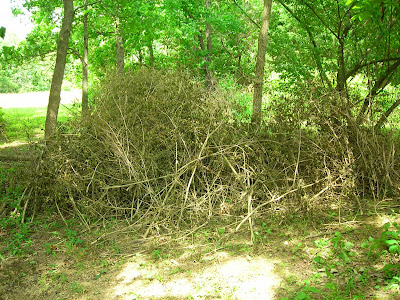 |
| Mullberry tree next to a Cedar |
Over the past few weeks mulberries have started to ripen. I only have four mulberry tree's on the farm. I only knew where one was so when they started to ripen I looked around a few fields, and found 3 more. So far I have seen four kinds of animals feeding at these bushes. Of course your general flying bird species eat them. If you ever see purple bird poop then there is a good chance there are mulberries somewhere around you. The other three animals have been deer, racoons, and turkeys (yes a bird but spends a lot of time on the ground). I wish I had pictures of them eating there, but I always forget my camera when I go to pick berries.
The tree is deciduous (leaves fall off), has simple leaves (single leaves) in an alternating pattern. The fruit of the tree does not all become ripe at the same time. The red mulberry (which is the kind here) starts to ripen in late May or early June, and the fruit slowly ripens through the rest of June and July.

Harvesting these is harder than other berries because you have to go out every day or several times a week at least to collect them. Since they fall off the tree when ripe if you do not collect often they will hit the ground and rot, or animals will eat them. Picking the berries is not hard though. If they are ripe they will pretty much fall off when you touch them or with a gentle tug. The stem will come off with the berry when you pull them off. You can also lay an old blanket down under the tree, shake the limbs, and the ripe berries will fall off. If the tree has not been pruned to be short then it can be hard to reach the higher branches to do this, and you will need a ladder. I might in fact set up a small scaffold system next year to hold up a blanket to catch the falling berries when they are ripe. Oh one more thing about picking these berries. They stain really really bad. Make sure you are not wearing any clothes you want to ruin when you pick or cook with these bad boys.
The berries look a lot like blackberries. Their shape is slightly different, but the bigger mulberries can be longer than most blackberries. They are slightly sweeter, and slightly less tart than a blackberry. They become more sweet and less tart as they ripen. I have not cooked anything
with these berries yet such as jams or pies. From the canning recipes I have read though you can follow a basic blackberry jam recipe, and do fine with it. If I collect enough to do some cooking though I will make another post with the results.
I have also saved a few seeds, and I am trying to grow more. I have not been able to find much information about growing them. I have read that growing them from seeds makes a better tree, but they do not transplant well so you should move them as quickly as possible once they sprout. I will try to record some information about their growth to help other people who might want to grow some.
I will hopefully be making at least one blog post a week to keep you all entertained. Blackberries and raspberries will be ripening soon, and hopefully I can get some good pictures of those for you you guys. Well it is time to go get some work done, seeya later.
 We have a few honey locust trees down on the farm. My father says there used to be more of them, but when I was very small something killed most of them off. They are a pretty tree, but they have some really wicked thorns on them. The tree does not get its name from being a good
honey plant. It is given the name because of the sweet taste of its seed
pods.
We have a few honey locust trees down on the farm. My father says there used to be more of them, but when I was very small something killed most of them off. They are a pretty tree, but they have some really wicked thorns on them. The tree does not get its name from being a good
honey plant. It is given the name because of the sweet taste of its seed
pods.





